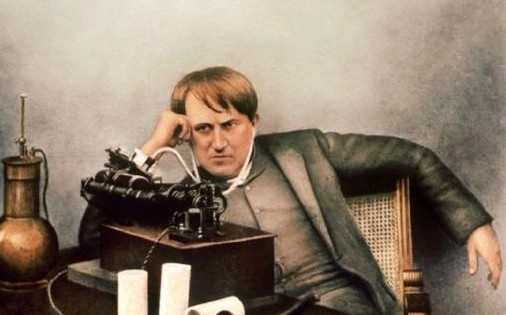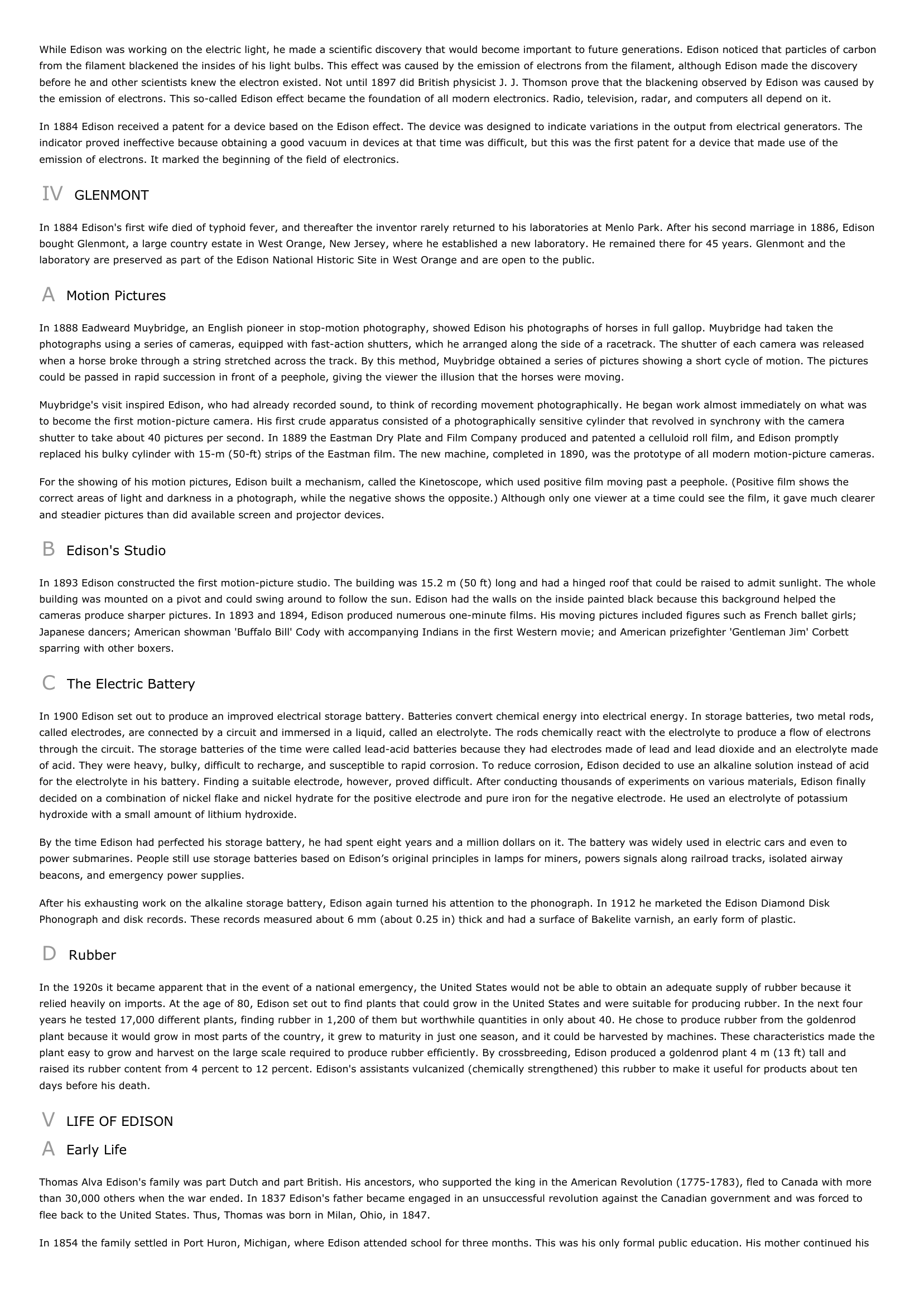Thomas Edison - USA History.
Publié le 02/05/2013
Extrait du document


«
While Edison was working on the electric light, he made a scientific discovery that would become important to future generations.
Edison noticed that particles of carbonfrom the filament blackened the insides of his light bulbs.
This effect was caused by the emission of electrons from the filament, although Edison made the discoverybefore he and other scientists knew the electron existed.
Not until 1897 did British physicist J.
J.
Thomson prove that the blackening observed by Edison was caused bythe emission of electrons.
This so-called Edison effect became the foundation of all modern electronics.
Radio, television, radar, and computers all depend on it.
In 1884 Edison received a patent for a device based on the Edison effect.
The device was designed to indicate variations in the output from electrical generators.
Theindicator proved ineffective because obtaining a good vacuum in devices at that time was difficult, but this was the first patent for a device that made use of theemission of electrons.
It marked the beginning of the field of electronics.
IV GLENMONT
In 1884 Edison's first wife died of typhoid fever, and thereafter the inventor rarely returned to his laboratories at Menlo Park.
After his second marriage in 1886, Edisonbought Glenmont, a large country estate in West Orange, New Jersey, where he established a new laboratory.
He remained there for 45 years.
Glenmont and thelaboratory are preserved as part of the Edison National Historic Site in West Orange and are open to the public.
A Motion Pictures
In 1888 Eadweard Muybridge, an English pioneer in stop-motion photography, showed Edison his photographs of horses in full gallop.
Muybridge had taken thephotographs using a series of cameras, equipped with fast-action shutters, which he arranged along the side of a racetrack.
The shutter of each camera was releasedwhen a horse broke through a string stretched across the track.
By this method, Muybridge obtained a series of pictures showing a short cycle of motion.
The picturescould be passed in rapid succession in front of a peephole, giving the viewer the illusion that the horses were moving.
Muybridge's visit inspired Edison, who had already recorded sound, to think of recording movement photographically.
He began work almost immediately on what wasto become the first motion-picture camera.
His first crude apparatus consisted of a photographically sensitive cylinder that revolved in synchrony with the camerashutter to take about 40 pictures per second.
In 1889 the Eastman Dry Plate and Film Company produced and patented a celluloid roll film, and Edison promptlyreplaced his bulky cylinder with 15-m (50-ft) strips of the Eastman film.
The new machine, completed in 1890, was the prototype of all modern motion-picture cameras.
For the showing of his motion pictures, Edison built a mechanism, called the Kinetoscope, which used positive film moving past a peephole.
(Positive film shows thecorrect areas of light and darkness in a photograph, while the negative shows the opposite.) Although only one viewer at a time could see the film, it gave much clearerand steadier pictures than did available screen and projector devices.
B Edison's Studio
In 1893 Edison constructed the first motion-picture studio.
The building was 15.2 m (50 ft) long and had a hinged roof that could be raised to admit sunlight.
The wholebuilding was mounted on a pivot and could swing around to follow the sun.
Edison had the walls on the inside painted black because this background helped thecameras produce sharper pictures.
In 1893 and 1894, Edison produced numerous one-minute films.
His moving pictures included figures such as French ballet girls;Japanese dancers; American showman 'Buffalo Bill' Cody with accompanying Indians in the first Western movie; and American prizefighter 'Gentleman Jim' Corbettsparring with other boxers.
C The Electric Battery
In 1900 Edison set out to produce an improved electrical storage battery.
Batteries convert chemical energy into electrical energy.
In storage batteries, two metal rods,called electrodes, are connected by a circuit and immersed in a liquid, called an electrolyte.
The rods chemically react with the electrolyte to produce a flow of electronsthrough the circuit.
The storage batteries of the time were called lead-acid batteries because they had electrodes made of lead and lead dioxide and an electrolyte madeof acid.
They were heavy, bulky, difficult to recharge, and susceptible to rapid corrosion.
To reduce corrosion, Edison decided to use an alkaline solution instead of acidfor the electrolyte in his battery.
Finding a suitable electrode, however, proved difficult.
After conducting thousands of experiments on various materials, Edison finallydecided on a combination of nickel flake and nickel hydrate for the positive electrode and pure iron for the negative electrode.
He used an electrolyte of potassiumhydroxide with a small amount of lithium hydroxide.
By the time Edison had perfected his storage battery, he had spent eight years and a million dollars on it.
The battery was widely used in electric cars and even topower submarines.
People still use storage batteries based on Edison’s original principles in lamps for miners, powers signals along railroad tracks, isolated airwaybeacons, and emergency power supplies.
After his exhausting work on the alkaline storage battery, Edison again turned his attention to the phonograph.
In 1912 he marketed the Edison Diamond DiskPhonograph and disk records.
These records measured about 6 mm (about 0.25 in) thick and had a surface of Bakelite varnish, an early form of plastic.
D Rubber
In the 1920s it became apparent that in the event of a national emergency, the United States would not be able to obtain an adequate supply of rubber because itrelied heavily on imports.
At the age of 80, Edison set out to find plants that could grow in the United States and were suitable for producing rubber.
In the next fouryears he tested 17,000 different plants, finding rubber in 1,200 of them but worthwhile quantities in only about 40.
He chose to produce rubber from the goldenrodplant because it would grow in most parts of the country, it grew to maturity in just one season, and it could be harvested by machines.
These characteristics made theplant easy to grow and harvest on the large scale required to produce rubber efficiently.
By crossbreeding, Edison produced a goldenrod plant 4 m (13 ft) tall andraised its rubber content from 4 percent to 12 percent.
Edison's assistants vulcanized (chemically strengthened) this rubber to make it useful for products about tendays before his death.
V LIFE OF EDISON
A Early Life
Thomas Alva Edison's family was part Dutch and part British.
His ancestors, who supported the king in the American Revolution (1775-1783), fled to Canada with morethan 30,000 others when the war ended.
In 1837 Edison's father became engaged in an unsuccessful revolution against the Canadian government and was forced toflee back to the United States.
Thus, Thomas was born in Milan, Ohio, in 1847.
In 1854 the family settled in Port Huron, Michigan, where Edison attended school for three months.
This was his only formal public education.
His mother continued his.
»
↓↓↓ APERÇU DU DOCUMENT ↓↓↓
Liens utiles
- Thomas Paine - USA History.
- Thomas Jefferson - USA History.
- EDISON Thomas Alva
- Thomas Edison par Hoang-Tchang-Fong Maître de Recherches du CNRS.
- Thomas Alva Edison - ciencia y tecnologia.

































